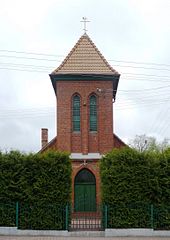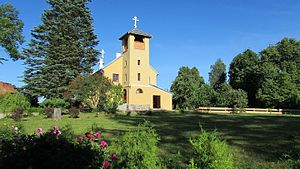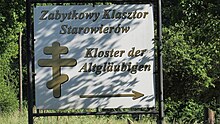Wojnowo (Ruciane-Nida)
| Wojnowo | ||
|---|---|---|

|
|
|
| Basic data | ||
| State : | Poland | |
| Voivodeship : | Warmia-Masuria | |
| Powiat : | Pisz | |
| Gmina : | Ruciane-Nida | |
| Geographic location : | 53 ° 40 ' N , 21 ° 29' E | |
| Residents : | 319 (2011) | |
| Postal code : | 12-220 | |
| Telephone code : | (+48) 87 | |
| License plate : | NPI | |
| Economy and Transport | ||
| Street : | Ukta / DE 609 / DW 610 ↔ DK 58 | |
| Ivanovo - Zameczek → Wojnowo | ||
| Osiniak-Piotrowo → Wojnowo | ||
| Rail route : | no rail connection | |
| Next international airport : | Danzig | |
Wojnowo [ vɔi̯ˈnɔvɔ ] ( German Eckertsdorf ) is a Polish town with around 300 inhabitants in the municipality of Ruciane-Nida (Rudczanny / Niedersee - Nieden) in the Powiat Piski (district of Johannisburg ) in the Warmian-Masurian Voivodeship .
Geographical location
The elongated village is located east of the Jezioro Duś ( German Dusssee ) and the river Krutynia ( Kruttinna ) on the edge of the Johannisburger Heide ( Polish Puszcza Piska ) in the historical region of East Prussia . It is five kilometers northwest of Ruciane-Nida and 17 kilometers southwest of Mikołajki (Nikolaiken) . It is 25 kilometers to the former district town of Sensburg ( Mrągowo in Polish ) and 22 kilometers to today's district metropolis of Pisz ( Johannisburg in German ).
history
Eckertsdorf was founded in 1828 and was one of eleven settlements of the Russian Orthodox sect of Old Believers . The local community belonged to the so-called Philipponen subgroup . The Filipinos persecuted in the Russian Empire settled in East Prussia, especially in Masuria , due to the liberal Prussian religious laws.
On February 18, 1835, the Gumbinn government president confirmed the founding of new "establishments" - including Eckertsdorf - in the Sensburg district by "the Philippones sect who immigrated from Poland", which have now been recognized as independent municipalities. In 1874 Eckertsdorf came to the newly established district of Ukta ( (Old) Ukta ), which until 1945 became the district of Sensburg in the administrative district of Gumbinnen (from 1905: administrative district of Allenstein ) in the Prussian province of East Prussia .
Due to the provisions of the Versailles Treaty , the population in the Allenstein voting area , to which Eckertsdorf belonged, voted on July 11, 1920 on whether they would continue to belong to East Prussia (and thus to Germany) or join Poland. In Eckertsdorf, 320 residents voted to remain with East Prussia, Poland did not cast any votes.
The end of the Second World War meant the end of the Philippine community. After the invasion of the Red Army , the village was placed under Polish administration and received the Polish form of name "Wojnowo". Until 1945 the place belonged to the district Sensburg, while it is now assigned to the powiat Piski (district Johannisburg ). Wojnowo is the seat of a Schulzenamt ( Polish Sołectwo ) and as such a place in the network of the urban and rural community Ruciane-Nida (Rudczanny / Niedersee - Nieden) , until 1998 the Suwałki Voivodeship , since then part of the Warmian-Masurian Voivodeship .
Population development
| year | number | Remarks |
|---|---|---|
| 1867 | 405 | |
| 1885 | 392 | |
| 1898 | 479 | |
| 1905 | 533 | |
| 1910 | 527 | |
| 1933 | 593 | |
| 2011 | 319 |
church
Evangelical
Eckertsdorf resp. Wojnowo was in is not a Protestant church village. The village belonged to the church Aweyden ( Polish: Nawiady ) until 1846 , then until 1945 to the church Alt Ukta in the church province of East Prussia of the Church of the Old Prussian Union . Today the Petrikirche in Ukta is the closest Evangelical church, which is looked after by the parish in Mikołajki (German Nikolaiken ) in the diocese of Masuria of the Evangelical-Augsburg Church in Poland .
Catholic
On the Catholic side, Eckertsdorf was parish in the Bischofsburg ( Polish Biskupiec ) until 1861 , then until 1945 in Sensburg (Mrągowo) in the Diocese of Warmia . Today the closest Catholic parish is that of the Ukta Exaltation Church in the Ełk Diocese of the Roman Catholic Church in Poland .
Orthodox
In Wojnowo is in the north east on the road to Osiniak-Piotrowo ( German Fedorwalde-Peterhain ) the orthodox parish and monastery church "Dormition of the Mother of God" ("Cerkiew Zaśnięcia Matki Bożej"). It belongs to the Polish Orthodox Church ("Polski Autokefaliczny Kościół Prawosławny"). The church was built between 1921 and 1923 according to the plans of the architect Aleksander Avajew from Tver, Russia, in the style of a wooden church and was ceremoniously consecrated in 1923. The parish, which was rededicated on September 1, 1996, belongs to the Bialystok-Gdańsk Diocese of the Polish Orthodox Church, which has its seat in Białystok . The church in Wojnowo has been a listed building since 1983.
The initial spark for the construction of the church was given by a Russian Orthodox clergyman prisoner of war during the First World War. He had succeeded in winning back many of the Philippons in Eckertsdorf for the Russian Orthodox faith.
Other
Old Believers
East of the main street that runs through the town is the brick church of the Old Believers ("Wschodni Kościół Staroobrzędowy"), built in neo-Gothic style , which the Philippons once used for their services. The church was built between 1923 and 1927 and consecrated in 1927. It has also been a listed building since 1983. The head office of the church is located in Suwałki .
Culture and sights
Former Old Believer monastery
The former Philippon monastery with the last name "Monaster Zbawiciela Trójcy Święty" ("Holy Redeemer and Trinity Monastery") dates back to the 1830s, when the monk Lavrenti Rastropin on the east bank of the Dusssee ( Jezioro Duś in Polish ) one founded a small hermitage. As early as 1834, the Philipponen, a group of Russian Old Believers , were given permission to build a church, just as it was in the neighboring town of Schönfeld ( Ładne Pole in Polish ). The monastery complex with its own church was built between 1839 and 1849, which made Eckertsdorf an important and worldwide religious center from 1852 to 1867. As a monastery, it also aroused the interest of the co-religionists of Moscow's Preobrazhenskoye cemetery , who provided advice and support.
In 1867 the then authoritative and leading prior Pawel Pruski ("Piotr Iwanowicz Ledniew") left Masuria and went to Russia to convert to the Russian Orthodox Church . As a result, monastic life got into a serious crisis and the monastery complex even threatened to deteriorate until it came into the possession of a wealthy Old Believer in 1884. A year later a nun bought the monastery back from him and led it to a new prosperity with up to 25 sisters as a women's monastery - until the First World War.
The monastery buildings survived the Second World War. Here Matron Antonia, who died in 1972, did a great job of building the facility. In 1988 two women lived here. The last of them died in 2006. Their death sealed the end of the monastery. Numerous icons from Russia, most of them from the Preobrazhensky Monastery in Moscow, are still part of the inventory today and make it an important destination for tourists. Supervision of the facility was legally assigned to a private family.
In addition to a church, the monastery also consists of old houses on the lake shore. Behind the church there is an orthodox cemetery with typical wooden crosses. This was renovated in summer 2008 by volunteers from Germany and Poland.
A circular hiking trail from the monastery to the Old Believers' places of 17 km in length was also created.
traffic
Wojnowo is on a side street that leads from Ukta ( (Old) Ukta ) south to state road 58 , with the houses lining almost the entire street. In addition, smaller roads lead from neighboring towns to here.
Until 1945 Ukta was the next train station. It was located on the railway line from Königsberg to Rudczanny (1938 to 1945: Lower Lake, today dissolved in the city of Ruciane-Nida ) , the last section of which was discontinued as a result of the war.
Personalities
Native of the place
- Feodor Szerbakow (Theodor Szerbakowski) (born February 20, 1911 in Eckertsdorf), German painter († 2009)
Web links
Individual evidence
- ↑ Polish Postal Code Directory 2013, p. 1474
- ^ Dietrich Lange, Geographical Location Register East Prussia (2005): Eckertsdorf
- ↑ a b c Artur Szmigiel, From the history of the Old Believers - in Masuria
- ^ Official Gazette No. 7 Gumbinnen, February 18, 1835
- ^ Rolf Jehke, Ukta district
- ↑ Herbert Marzian , Csaba Kenez : self-determination for East Germany. Documentation on the 50th anniversary of the East and West Prussian referendum on July 11, 1920. Editor: Göttinger Arbeitskreis , 1970, p. 112
- ↑ Wykaz sołtysów Gminy Ruciane-Nida ( Memento of the original dated December 30, 2017 in the Internet Archive ) Info: The archive link was inserted automatically and has not yet been checked. Please check the original and archive link according to the instructions and then remove this notice.
- ↑ Eckertsdorf at GenWiki
- ^ Uli Schubert, community register, district Sensburg
- ^ Michael Rademacher: German administrative history from the unification of the empire in 1871 to the reunification in 1990. District Sensburg (Polish Mragowo). (Online material for the dissertation, Osnabrück 2006).
- ^ Wieś Wojnowo w liczbach
- ↑ Walther Hubatsch , History of the Protestant Church in East Prussia , Volume 3 Documents , Göttingen 1968, p. 500
- ↑ a b c Wojnowo - Eckertsdorf and the Philipponen
- ↑ a b c Monastery on Drußsee
- ↑ Walther Hubatsch, History of the Protestant Church in East Prussia , Volume 1, Göttingen 1968, p. 302









